![]()
![]()
![]()
Use LEFT and RIGHT arrow keys to navigate between flashcards;
Use UP and DOWN arrow keys to flip the card;
H to show hint;
A reads text to speech;
125 Cards in this Set
- Front
- Back
|
Biology |
The study of living organisms/life |
|
|
7 Basic characteristics of living things |
Organized. Aquire materials & energy, reproduce, grow and develop, homeostatic, evolutionary history, respond to stimuli |
|
|
Organized |
We're made up of chemicals, molecules and they are organized in such a way that results in life. |
|
|
Molecules are organized within the |
Cell |
|
|
What are some examples of organelles |
Mitochondria, nucleus, smooth and rough er |
|
|
What is an Organelle |
Typically a membrane-bound structure suspended in the cytosol; hair-like projections from the cell may also be called organelles |
|
|
Do organelles have different divisions of labor? |
Yes |
|
|
How is tissue formed |
By cells working with other cells |
|
|
What is tissue |
Typically Cells working together to form a common function |
|
|
What are Organs made up of |
2 or more different tissues that are working together to perform a particular function |
|
|
What are organelles within |
Cells |
|
|
Organ |
A structure composed of more than one tissue having one or more specific functions |
|
|
Organ system |
A group of Organs that perform a broad biological function, such as respiration or reproduction |
|
|
Cell |
The smallest unit of life, contained in a membrane or cell wall |
|
|
What makes up the organism |
Organ system |
|
|
Aquire materials & energy |
Eating and drinking. We have to do this to stay alive. One of the 7 |
|
|
What aquires materials and energy |
Animals. Plants (energy from the sun, co2, water). One of the 7 |
|
|
Reproduce |
One of the 7. Organisms need to be able to reproduce |
|
|
Growth and development |
One of the 7. Organisms grow and develop. We start off as an egg |
|
|
How did we all start |
As a fertilized egg which sperm fertiized. |
|
|
Zygote |
A single cell |
|
|
A fertilized egg is a |
Zygote |
|
|
Homeostasis
|
State of body equilibrium. Where the body's internal environment remains relatively constant and within physiological limits. Living things have to be able to regulate their internal parameters. One of the 7 |
|
|
In homeostasis things have to be regulated within |
Narrow physiological parameters. Ex.) Blood sugar can't be too high or too low. Has to be in that narrow physiological range. Too high or low results in illness or diseased state |
|
|
What happens when homeostasis isn't happening |
Illness, disease, or death |
|
|
Evolutionary History |
We came from a mom and a dad. They're parents came from a mom and a dad and so on and so forth and that's our evolutionary history. One of the 7 |
|
|
Respond to stimuli |
Living things respond to stimuli. One of the 7. If you tip a plant over horizontally the plant growing up toward sunlight is responding to stimuli |
|
|
What are some examples of homeostasis |
In the body - Salt concentration level, blood sugar level, body temp, hormone levels - all these levels cant get too high or too low |
|
|
What is one of the ways we maintain homeostasis |
Negative feedback |
|
|
Negative feedback |
operates to reduce or eliminate the changes detected by the stimulus receptor. Ex.) Our body picking up that we are below 98.6 body temp and eliminating the change (the drop in body temp) |
|
|
What are some examples of operations to reduce or eliminate the changes detected by the stimulus receptor |
Muscles contacting when you shiver to generate heat. sweat glands produce sweat which evaporates off our skin it pulls heat away from the body |
|
|
Cell |
Smallest basic unit of life. There's nothing smaller than the cell that we consider alive |
|
|
How small is a human cell |
Most are between 10-100 ųm(micrometers) in diameter. (Human hair diameter is 100 ųm or 1/10 millimeter) |
|
|
How many different types of cells are there in the human body |
200 |
|
|
How many cells are there in the human body |
50-60 trillion cells |
|
|
Why do cells have to be so small |
Diffusion. When the volume is too large relative to surface area, or the surface area to volume ratio is too small, diffusion can not occur at high enough rates to supply it's raw materials to the whole volume of the cell |
|
|
Where does diffusion happen |
Everywhere |
|
|
Diffusion |
The movement of a substance that goes from a high concentration to a low concentration |
|
|
What is an example of the movement of a substance that goes from a high concentration to a low concentration |
Raid is sprayed to kill a roach. 5 min later the whole room smells like raid. The molecules are diffusing. The puddle of raid is evaporating going from high concentration to low |
|
|
What are capillaries |
The smallest of all the blood vessels |
|
|
What do cells need |
Oxygen. And glucose for energy |
|
|
How does glucose and oxygen get to cells |
Through capillaries by diffusion. The get to the cells just outside the capillaries |
|
|
Diffusion only works efficiently over ___________. And example of this is ____________. |
Very small distances (less than a micrometer). Ex.) Someone's heart stops beating but they need oxygen. Oxygen is all around us but Oxygen can't diffuse from the air into our skin into the cells |
|
|
If cells were really big |
Diffusion could not occur efficiently |
|
|
How does the heart get energy |
Coronary arteries branch into smaller arteries and then capillary beds and that's how the heart gets the oxygen and glucose it needs in order to produce energy. Cells have to be small for effective diffusion |
|
|
In order for cells to diffuse efficiently they need to have |
A high surface area to volume ratio |
|
|
Bi concave - what is is and what is biconcave in your body? |
It's like you let air out of a basketball so there's just a little air in the basketball and you're pressing inward on both ends of the basketball. |
|
|
Why are cells biconcave |
Because there is a larger surface area to volume ratio |
|
|
How do you find the surface area of one side |
Length × height |
|
|
How do you find the surface area of an entire cube |
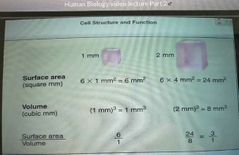
Find the surface area of one side. Then multiply the surface area of that one side by the amount of sides.
|
|
|
How do you get the volume |
Width×length×height |
|
|
How do you get the ratio |
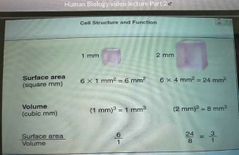
Put surface area over volume then simplify |
|
|
How is surface area and volune related to how large or small a cell is? |
The greater the size of a cell the less surface area it has relative to it's volume |
|
|
Would the rate if diffusion for a large cell be the same as a small? |
Yes, but the small would be fully diffused faster because there is a larger surface area to volume ratio |
|
|
What is cell theory and what does it state |
It is a major theory in biology thats states that 1- a cell is the basic unit of life (nothing smaller than a cell is considered alive) 2 - all living things are made up of cells. 3 - new cells arise only from pre-existing cells |
|
|
Is anything smaller than a cell alive? |
No. Ex.) Golgi apparatus, Mitochondria, rough er, smooth er |
|
|
Are bacteria made up of cells? |
Bacteria is a single celled organism |
|
|
Are all living things made up of cells? |
Yes |
|
|
What are the 2 categories of cells |
Prokaryotes and Eukaryotes |
|
|
Prokaryotes |
No membrane-bound nucleus and membranous organelles. |
|
|
What are examples of porokaryotes |
Bacteria and archaea |
|
|
What are bacteriea and Archaea |
Extremifiles, single celled microorganisms, that can be found in extreme places. Ex. Thermal vents at the bottom of the ocean |
|
|
Eukaryotes |
Has membrane bound necleus and membranous organelles |
|
|
What are examples of eukaryotes |
Animals, plants, fungi, and protists. Made up of eukaryotic cells |
|
|
Are there only eukaryotic cells in our bodies? |
No, there are also prokaryotic cells in our bodies |
|
|
Cover up names of the animal cell and identify the parts |
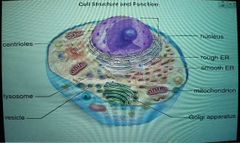
|
|
|
Plasma membrane |
Outer membrane that regulates what enters and leaves the cell. It is the Boundary between the outside and inside of the cell. |
|
|
Why do they call the plasma membrane selectively permeable? |
Because it allows certain molecules to enter and exit, and doesn't allow other things to enter/exit |
|
|
We talk about plasma membranes a a fluid-mosaic model. What does this mean |
It means you've got this phospholipid bilayer and embedded in the bilayer are proteins. The fluid-mosaic model let's us know that the proteins are not fixed in position. They can move about within the plasma membrane |
|
|
Cover up and Identify parts of the phospholipid bilayer |
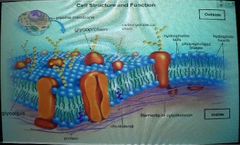
|
|
|
What are the phospholopids |
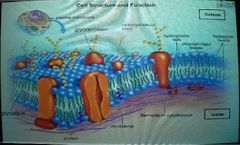
The blue balls |
|
|
Why is it called a phospholipid bi layer |
Because there are 2 layers (refer to picture) |
|
|
hydrophilic |
Loving water, wants to be by water |
|
|
What is something that is hydrophilic |
The phospholipid (blue racketball-like thing) |
|
|
What are phospholipids composed of |
Glycerol and phosphate group |
|
|
What are the streamers attached to the phospholipid |
Hydrophobic tails that are fatty acids |
|
|
Hydrophobic |
Hates water. Wants nothing to do with water |
|
|
Why does the phospholipid always face the outside or inside of the cell |
Because it's hydrologic and the outside of the cell is an aqueous/water environment. The inside of the cell is also an aqueous/water environment |
|
|
What are the hydrophobic tails/streamers facing? |
They are facing each other and only have to deal with themselves (no water) |
|
|
The proteins in the phospholipud bilayer are |

Red in the picture. Fluid mosaic. They can move about. Come through the top of the bilayer and the bottom. |
|
|
A particular protein in the bilayer serves as |
A chanel which allow particular chemicals to leave the cell or enter the cell |
|
|
Some proteins in the bilayer are only found |
On the inner or outer surface of the plasma membrane |
|
|
What are the hexagons coming out of the proteins in the picture |
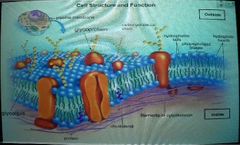
Glucose molecules or glycoprotein |
|
|
Why are glucose molecules/glycoprotein represented as hexagons |
They are a 6 carbon sugar |
|
|
Why are the glucose molecules (glycoprotein) attached to the proteins on the bilayer? |
The glycoproteins are name tags. Different cells know what cell is what base on these name tags |
|
|
Diffusion |
Movement of molecules or ions from a region of higher to lower concentration |
|
|
Does diffusion require any energy? |
No it happens naturally. Requires no energy- passive transport |
|
|
Equilibrium |
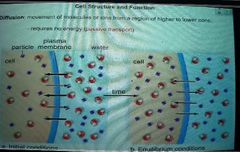
In diffusion when molecules move from a higher to lower concentration, it's getting the sense concentration of molecules inside the cell as outside the cell. Same thing with the particles. |
|
|
When we talk about diffusion, things like to go to |
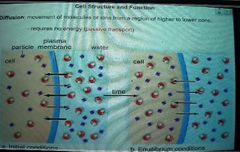
Equilibrium |
|
|
Are thing still going from one side to the other (movng in and out) after equilibrium? |

Yes. Thats what the arrows represent |
|
|
What does passive transport mean |
No additional energy is needed for a process to occur |
|
|
Osmosis |
Diffusion of water across a selectively permeable membrane |
|
|
Tonicity |
With the diffusion of water across a selectively permeable membrane - the 3 different outcomes that can occur- definition - The 3 osmotic characteristics of a solution across a particular membrane. |
|
|
What are the 3 outcomes of tonicity that we can get |
Isotonic solution. Hypertonic solution. Hypotonic solution |
|
|
Isotonic solution |
Same concentration of nondiffusable (salt Nacl) salutes and water on both sides of the plasma membrane. |
|
|
If you dropped blood cells into and isotonic solution what would happen |
Basically nothing. Nothing coming in, nothing going out |
|
|
Hypertonic solution |
Higher concentration of solutes (salt) and lower concentration of water outside the cell than inside the cell |
|
|
Hypotonic solution |
Lower concentration of solutes and higher concentration of water outside the cell than inside the cells |
|
|
Salt NaCl is diffusable or non diffusable? |
Nondiffusable |
|
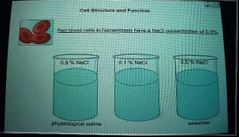
Order these |
Isotonic, hypotonic, hypertonic |
|
|
What happens if you put blood cells in a hypertonic solution |
Salt is non diffusable and the water is going to want to go to equilibrium so since the water in the cell is higher concentration it will diffuse. Go from higher to lower concentration and the blood cells will shrivel |
|
|
What happens if you put blood cells in a hypotonic solution |
The water diffuses once again from high to low concentration. So it will rush into the blood cells. The blood cells will then expand to the point at which it can pop |
|
|
Hypotonic acronym |
Hypo. Hippo. Hippos are huge. Blood cells are gonna get big |
|
|
Hypertonic acronym |
Kids are hyper af. Hyper kids are skinnier because they're always moving around. Blood cell is skinny. Shrivels |
|
|
What is another easy way to remember hypertonic and hypotonic in the blood cell salt solution example |
Water always follows salt |
|
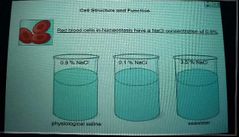
What happens to the cells when you put blood cells in each solution |

|
|
|
Red blood cells in solutions under microscope |
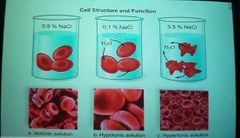
|
|

|
C |
|
|
Is diffusion a kind of transport? |
Yes |
|
|
Is diffusion a passive transport? Why or why not? |
Yes, because it doesn't require any additional energy to work, it just works naturally |
|
|
Facilitated transport |
Use of a plasma membrane carrier to move a substance into or out of a cell from higher to lower concentration |
|
|
When something is too big to cross the plasma membrane and it needs a helper molecule (ex. Proteins) to pass which is called |
Facilitated transport |
|
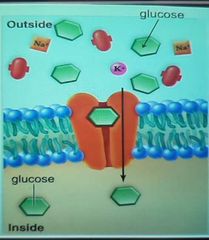
What is this showing |
Facilitated transport |
|
|
Will there always be more glucose inside or outside the cell? And what does this mean |
Outside. It means it's going to want to go from high concentration to low |
|
|
What does glucose need to pass down it's concentration gradient? |
Protein, which is the facilitated transport |
|
|
What's an example of how protein acts as a facilitated transport |
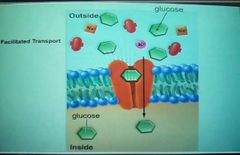
Glucose fits in the little groove of the protein, then the protein changes it's shape and releases the glucose inside the cell |
|
|
What kind of transport is a facilitated transport? |
Passive transport. Needs no additional energy to work |
|
|
Active transport |
Use of plasma membrane carrier to move a substance into or out of a cell from lower to higher concentration. Energy is required, usually ATP |
|
|
What does ATP stand for |
Adenosine triphosphate |
|
|
Are you moving down the concentration gradient with active transport? |
No, you are not going from high to low concentration. You are going against the concentration gradient |
|
|
What doesn't happen by itself and needs additional energy to work within active transport |
Taking something that's at a low concentration and stock piling it so it's at a higher concentration |
|
|
What do we need to stockpile a particular molecule within the active transport process |
The energy we need for the process to work is by utilizing atp |
|
|
ATP |
Basic Energy currency of the cell. Dollar bill of the cell. |
|
|
What does active transport utilize |
A plasma membrane carrier (a protein) |
|
|
Whats the blueberry example of atp |
You're picking blue berries from all around. There's alot of space so that's a high concentration. You're putting them in your basket which is a low concentration. It requires energy for you to do this |

